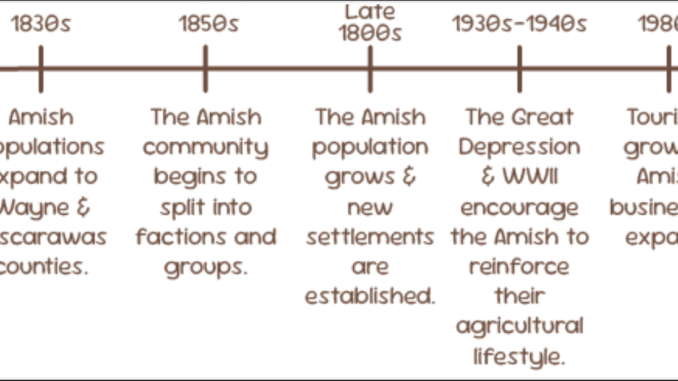
photo credit: Mia Harrington
In Central Ohio, seeing a group of Amish people in public can be a rare sight. Many people stare, take pictures or even claim how much they adore Amish people, but not many actually know what it means to be Amish and only view the Amish as people living in the past.
Many think that every Amish person they see practices the same exact beliefs and customs, which leads to confusion and stereotyping. The Amish are Anabaptists who emphasize things such as mutual aid, family and forgiveness, according to Elizabethtown College. However, they often get grouped into one set of standards along with other groups such as Mennonites, which are different in their practices and beliefs despite sharing some lifestyles with the Amish.
“Common misconceptions are that the Amish are all alike, when in fact there are many different ways to be Amish,” Professor David Weaver-Zercher said. Weaver-Zercher holds a Ph.D. in religion and teaches American religious history at Messiah University.
Ohio has the second largest Amish population in the world. Holmes County, located in Northeast Ohio, has the largest population in the state with over 40,000 people, according to amishamerica.com.
“Ohio is home to about 86,000 Amish people of all ages. As of this past summer, there were 690 local Amish church districts in Ohio, in 74 different settlements,” Professor Steven Nolt said. Nolt, who has a Ph.D. in history, has written over a dozen books on the Amish, Mennonites and Pennsylvania German and teaches Anabaptist studies and history at Elizabethtown College.
One of the biggest things that confuse people on the Amish is which modern technologies they are allowed to use. It is often assumed that the Amish are completely removed from things such as batteries, tractors and telephones, but many groups that are less conservative do allow these resources to be used, according to amishamerica.com. Decisions on whether to allow these technologies are often made by individual churches.
“All decisions within Amish communities are made by consensus, with each member, male and female, having a say. When debating whether to adopt something new, like cell phones, they weigh the pluses and minuses before making a decision,” Professor Mark Louden said, who holds a Ph.D. in Germanic Linguistics and teaches at the University of Wisconsin-Madison. He also works as an interpreter and mediator for some Amish and Mennonite groups.
A common sight in areas populated by the Amish are horses and buggies, which strengthen communal ties and serve as a traditional symbol of the Amish and Mennonites. Buggies travel at around five to eight miles per hour, and households often own multiple buggies that are usually made locally, according to amishamerica.com.
“For most Amish in most settlements, buggy transportation is the primary form of local transportation. In some more change-oriented settlements, it is very common for Amish people to hire non-Amish drivers to take them to longer trips or even on shorter local trips to the store or doctor’s office. Among the more conservative subgroups, hiring a driver is done only in cases of real emergency or necessity,” Nolt said.
Another distinct telling of an Amish person, and what type of Amish they are, is their clothing.
“Amish dress is modest and varies according to subgroups, of which there are many. Females usually have their heads covered with what in Pennsylvania Dutch is called a Kapp. Men usually wear broadfall pants that are closed with buttons rather than zippers. Styles of Amish dress do not change rapidly over time; however, many groups now use polyester material for clothing rather than cotton since polyester garments dry faster and wrinkle less easily,” Louden said.
Many people think of agriculture and farming as the Amish’s main income source, when a majority of Amish people are moving toward industries such as construction, woodworking, tourism, crafting and other small businesses within their communities. These businesses are largely successful, with one study finding that only five percent of Amish businesses fail within five years, giving Amish businesses a 95 percent success rate, according to amishvillage.com.
“Amish have a lot more businesses now than in the past because farmland has become more scarce and more expensive. Plus, there are many more Amish people now than in the past. There isn’t enough land for everyone to farm, so they start businesses (e.g., sawmills, construction, greenhouses) to make a living,” Weaver-Zercher said.
The Amish stay rooted to a simple lifestyle and the misconceptions around their ways of life often look over how thriving and dynamic their communities are.
“Many people assume that the Amish reject technology completely and are frozen in time. Both these stereotypes are incorrect. All Amish make limited use of some aspects of technology, and they do definitely change over time, just in ways different from their non-Amish neighbors,” Louden said.


